

Proa. Plan of a Micronesian proa, from a 1742 sketch by Lt.
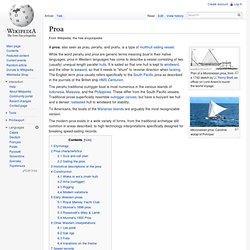
Peircy Brett, an officer on Lord Anson's round-the-world voyage Micronesian proa, Caroline walap of Pohnpei A proa, also seen as prau, perahu, and prahu, is a type of multihull sailing vessel. The perahu traditional outrigger boat is most numerous in the various islands of Indonesia, Malaysia, and the Philippines. These differ from the South Pacific vessels. To Americans, the boats of the Marianas Islands are arguably the most recognizable version. The modern proa exists in a wide variety of forms, from the traditional archetype still common in areas described, to high-technology interpretations specifically designed for breaking speed-sailing records. Etymology[edit] Proa sail hoisted, Netherlands, circa 1970 The "proa" was first documented by the Spanish Magellan expedition to the Philippines circa 1519 CE. Proa characteristics[edit] Size and sail plan[edit] Outrigger canoe. Unlike a single hulled canoe, an outrigger or double-hull canoe generates stability as a result of the distance between its hulls rather than due to the shape of each individual hull.
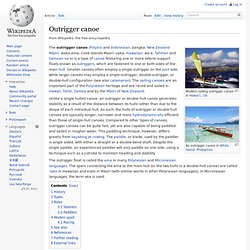
As such, the hulls of outrigger or double-hull canoes are typically longer, narrower and more hydrodynamically efficient than those of single-hull canoes. Compared to other types of canoes, outrigger canoes can be quite fast, yet are also capable of being paddled and sailed in rougher water. This paddling technique, however, differs greatly from kayaking or rowing. The paddle, or blade, used by the paddler is single sided, with either a straight or a double-bend shaft. Despite the single paddle, an experienced paddler will only paddle on one side, using a technique such as a J-stroke to maintain heading and stability. History[edit] The traditional pōpao of Tonga. Hawaiʻiloa, a double-hull sailing canoe built as a replica of Polynesian voyaging canoes. The technology has persisted into the modern age. Kayak Design Software. Like many kayak builders before me, having built a few different designs, I began to think about designing one of my own.

I was not prepared to pay for a commercial naval architecture package, and I thought it would be a fun project to develop my own kayak design software. KayakFoundry is the result. Version 1.6 is now available for download below. This is a free program, but contributions are welcome! Download: KayakFoundry 1.6.4 (November 14, 2009) KayakFoundry 1.6 Features: Stability Curves Multiple views for shaping the kayak in Plan, Profile, and Body Supports 1, 2, or 3 cockpits with independent or shared shapes Auto-positioned cockpit tracks with changes to center of buoyancy Resizable/hideable panels Waterlines and buttock lines Active Section view shows all section dimensions Curve shaping by dragging control points Rubber-banding for multiple control point selection Keyboard arrow keys provide fine adjustments of control point position.
KayakFoundry BBS. Yostwerks Kayak Building Manuals - Homebuilt kayaks by Thomas Yost. OutX03k.pdf (Objet application/pdf) Free SGPlans.pdf (Objet application/pdf) Bamboo Boats. "Just as the earthenware tigari replaces the skin coracle in Bengal and the tub boat is its equivalent in China and Japan, so in Tongking (Tonkin), in Indo-China, a closely woven basket boat is the parallel substitute.
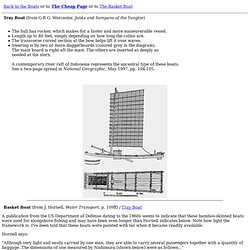
This is a light, graceful craft made of inch-wide strips of split bamboo, closely woven into stiff matting, a material of great strength, resiliency and resistance to strain. In plan it is an elongated ovate form, the wider end being the stern. Both extremities are spoon-shaped like the fore end of a Norwegian pram and are rounded in horizontal outline. A gentle sheer toward each end carries stem and stern above the level of the midships gunwale, the stem rising the higher.
[Emphasis and key letters on diagram by COD:] The bent-up sides of the bamboo body are embraced around their margin by several broad bands of split bamboo on each side and bound together into a stout cylinder with rattan strips to form a stout, continuous gunwale.
Kayak Anchor Float. Véliplane « Foilers ! Fin 2009, au salon Nautique, j’ai l’occasion d’évoquer avec des amis de l’association Golden Oldies Multihulls - Daniel Charles et Christian Février – ce qui a pu faire naitre chez Eric Tabarly l’idée d’utiliser des hydrofoils.
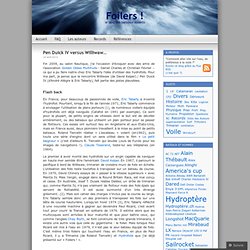
Pour ma part, je pense que la rencontre Williwaw (de David Keiper) / Pen Duick IV (d’André Allègre & Eric Tabarly), fait partie des pistes plausibles. Flash back En France, pour beaucoup de passionnés de voile, Eric Tabarly a inventé l’hydrofoil. Pourtant, lorsqu’à la fin de l’année 1971, Eric Tabarly commence à envisager l’utilisation de plans porteurs (1), de nombreux voiliers équipés d’hydrofoils ont déjà navigués (Catafoil en 1941 par exemple). Ce sont pour la plupart, de petits engins de vitesses dont le but est de décoller entièrement, ou des bateaux qui utilisent un plan porteur pour se passer de flotteurs. Le premier à avoir monté des hydrofoils sur un engin capable de naviguer en haute mer semble être l’américain David Keiper. Alors ? Www.svensons.com - Free Boat Plans From "Science and Mechanics" Magazines.
Free Boat Plans from "Science and Mechanics", "Boat Builder Handbook" and other very old magazines Trouble viewing?
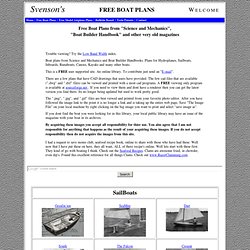
Try the Low Band Width index. Boat plans from Science and Mechanics and Boat Builder Handbooks. Frazer/Canoe Cruising and Camping/Contents.